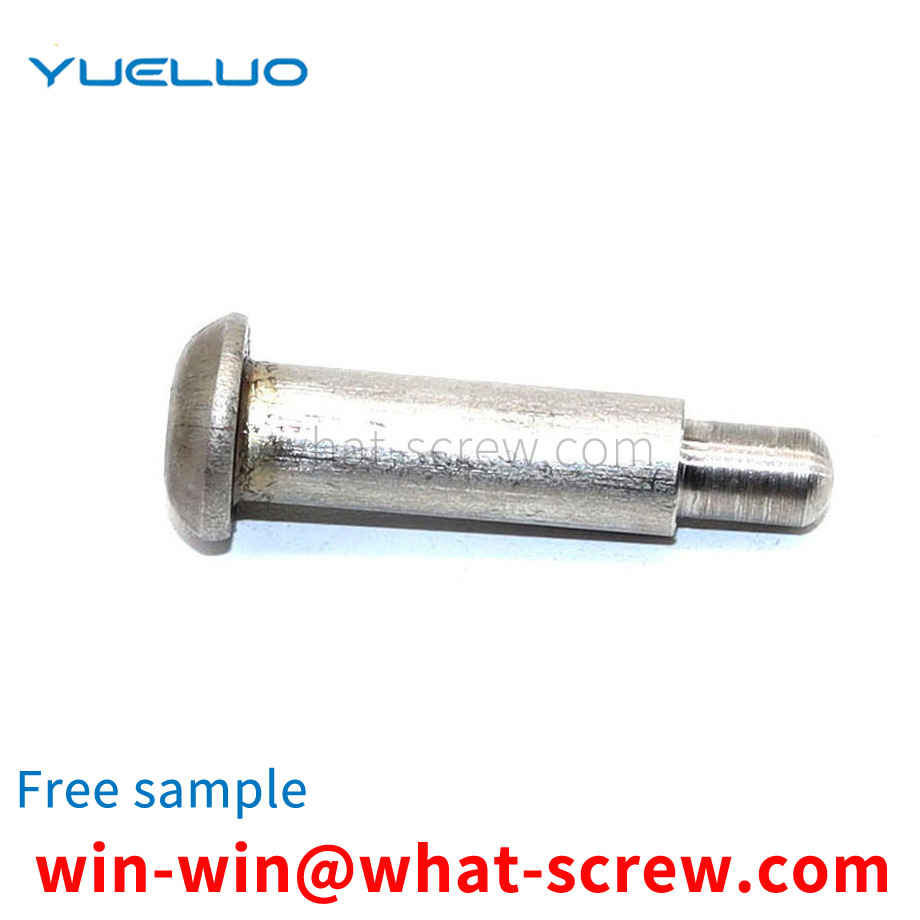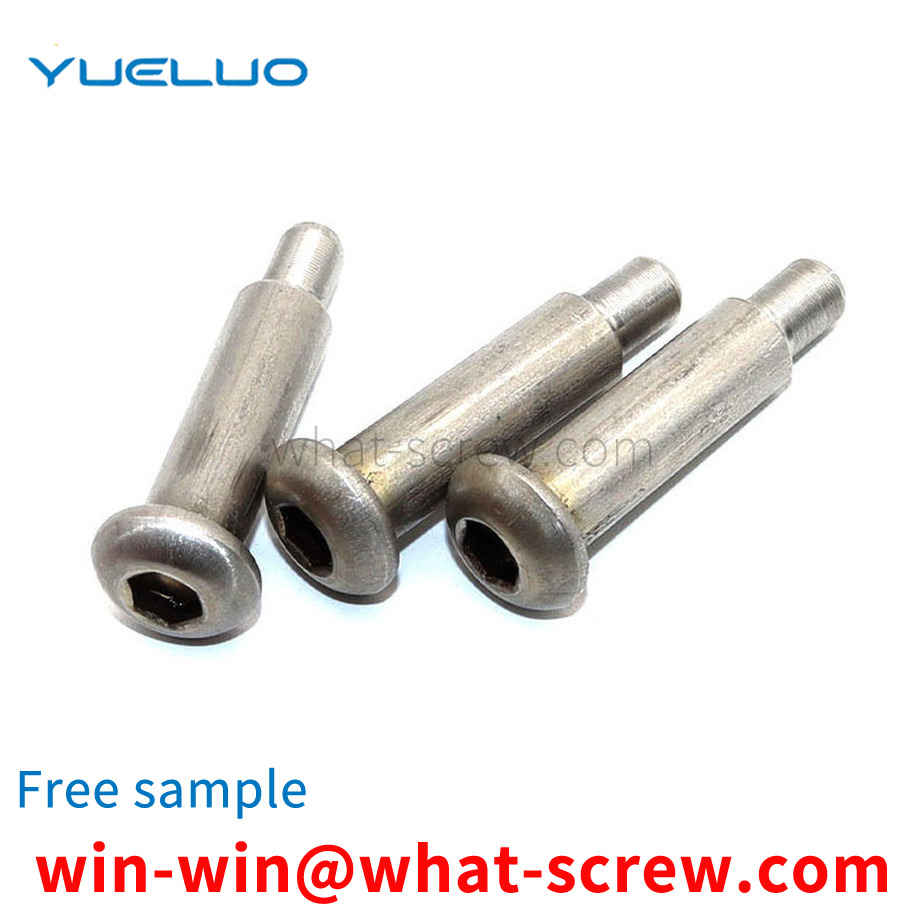Bolt: A type of fastener consisting of a head and a screw (a cylinder with an external thread), which needs to be matched with a nut to fasten and connect two parts with through holes. This form of connection is called a bolted connection. If the nut is unscrewed from the bolt, the two parts can be separated, so the bolt connection is a detachable connection. [1] Stud: A type of fastener that has no head and only has external threads on both ends. When connecting, one end of it must be screwed into the part with the internal threaded hole, the other end must pass through the part with the through hole, and then the nut must be screwed on, even if the two parts are tightly connected as a whole. This form of connection is called a stud connection, which is also a detachable connection. It is mainly used for occasions where one of the connected parts is thick, requires a compact structure, or is not suitable for bolt connection due to frequent disassembly. [1] Screw: It is also a type of fastener consisting of a head and a screw. It can be divided into three categories according to the purpose: machine screws, set screws and special-purpose screws. Machine screws are mainly used for a fastened connection between a part with a fixed threaded hole and a part with a through hole, without the need for nut matching (this connection form is called screw connection, which is also a detachable connection; it can also be Cooperate with the nut, it is used for the fast connection between two parts with through holes.) The set screw is mainly used to fix the relative position between the two parts. Special purpose screws, such as eyebolts, are used for hoisting parts. [1] Nuts: with internal threaded holes, generally in the shape of a flat hexagonal column, but also in a flat square column or flat cylindrical shape, with bolts, studs or machine screws, used to fasten and connect two parts, make it a whole. [1] 5. Self-tapping screw: Similar to machine screw, but the thread on the screw is a special thread for self-tapping screw. It is used to fasten and connect two thin metal components to make them a whole. Small holes need to be made in advance on the components. Due to the high hardness of this kind of screw, it can be directly screwed into the hole of the component, so that the Forming a corresponding internal thread [1] 6. Wood screw: It is also similar to a machine screw, but the thread on the screw is a special thread for wood screws, which can be directly screwed into wooden components (or parts) to connect a band through The metal (or non-metallic) part of the hole is fastened to a wooden member. This connection is also a detachable connection. [1] 7. Washers: A type of fastener with an oblate annular shape. It is placed between the supporting surface of the bolt, screw or nut and the surface of the connecting part, which increases the contact surface area of the connected parts, reduces the pressure per unit area and protects the surface of the connected parts from damage; another type of elastic washer, It can also play a role in preventing the nut from loosening. [1] 8. Retaining ring: It is installed in the shaft groove or shaft hole groove of the machine and equipment, and plays the role of preventing the parts on the shaft or the hole from moving left and right. [1] 9. Pins: mainly used for positioning the left and right parts, and some are also used for connecting parts, fixing parts, transmitting power or locking fasteners. [1] 10. Rivet: A type of fastener consisting of a head and a shank, which is used to fasten and connect two parts (or components) with holes to make them a whole. This form of connection is called rivet connection, or riveting for short. It is a non-removable link. Because if the two parts joined together are separated, the rivets on the parts must be broken. [1] 11. Components and connection pairs: Assemblies are a type of fasteners supplied in combination, such as a combination of a certain machine screw (or bolt, self-supplied screw) and a flat washer (or spring washer, lock washer); Connection pair refers to a type of fastener that is supplied by a combination of special bolts, nuts and washers, such as high-strength hexagon head bolt connection pairs for steel structures. [1] 12. Welding nail: a heterogeneous fastener composed of a nail rod and a nail head (or no nail head), which is fixed to a part (or component) by welding, so as to be connected with other parts. .
self-locking screw comprises a screw main body, a metal screw head is arranged on the upper part of the screw main body, a thread is arranged in the middle part of the screw main body, an interference groove is arranged on both sides of the upper part of the screw main body, and the line of the interference groove is arranged. The included angle is 280-364° with the horizontal line. The bottom of the screw body is provided with an elastic chuck, and the elastic chuck includes an optical axis and a conical head. Guangdong Yueluo Hardware Industry Co., Ltd. Guangdong Yueluo Hardware Industry Co., Ltd. adopts the design of elastic collet, and the screw is provided with threaded segments and interference grooves, so that during the screwing process, the interference groove of the optical axis between the two threaded segments is formed along the screw. The axial elastic force achieves the effect of reliable self-locking, which is easy to use and has high tuning efficiency.
The two combination screws are classified according to the national standard, including GB9074.2, GB9074.3, GB9074.5, etc. GB9074.3 refers to a two-component combination of a cross pan head screw and a foreign lock washer.
rivet is a nail-shaped object used to join two parts or components with a through hole and a cap on one end. In riveting, the riveted parts are connected by their own deformation or interference. There are many types of rivets, and they are not limited to the form. The existing switch is not easy to fix, and needs to be supported by others during installation, which leads to waste of labor, and at the same time, it is easy to damage the hands of the supporting personnel. The existing device driving method is relatively laborious. Some devices require rivets of different lengths in different thicknesses, and cannot be assembled by themselves of the same type.
The composition and proportion of this high-performance stainless steel screw thread are: 0.08%-0.15% C; 0.01%-0.60% Si; 0.02%-0.60% Mn; 0.01%-0.03% P; 0.002%- 0.03% S; 12%-14% Cr; 0.8%-1.5% Mo and the rest is Fe. The preparation method includes the following steps: smelting molten steel according to chemical composition requirements; hot rolling; annealing and pickling to obtain a stainless steel plate blank; coating and drying; cold drawing; cleaning and drying with a neutral activator; quenching; tempering ; coated and dried; drawn into stainless steel thread. This high-performance stainless steel screw line is energy-saving and environmentally friendly, with high corrosion resistance, high elasticity and high toughness. The preparation method and process are advanced and simple, and the production cost is low.
We have many years of experience in the production and sales of screws, nuts, flat washers, etc. The main products are: wave washers, GB6171 nuts, bearing steel positioning pins, shaft pin toy city connecting rod locks and other products, we can provide you with suitable tightening Firmware Solutions.



















 Service Hotline
Service Hotline




